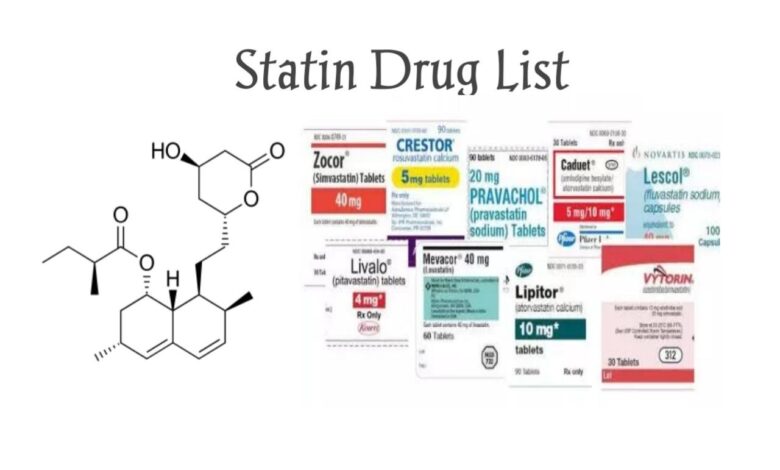Statin Drugs List

Statins are a class of drugs that are used to lower cholesterol. Your body needs some cholesterol to work properly. But if you have too much in your blood, it can stick to the walls of your arteries and narrow or even block them. Statins interfere with the production of cholesterol in your liver. They lower LDL (bad) cholesterol levels and raise HDL (good) cholesterol levels. This can slow the formation of plaques in your arteries.
By lowering the levels, they help prevent heart attacks and stroke. Studies show that, in certain people, statins reduce the risk of heart attack, stroke, and even death from heart disease by about 25% to 35%. Studies also show that statins can reduce the chances of recurrent strokes or heart attacks by about 40%.
Your doctor will consider all of your risk factors for heart attacks and strokes before prescribing a statin.
Knowing your cholesterol numbers is a good place to start.
- Total cholesterol. Most people should try to keep their total cholesterol below 200 milligrams per deciliter (mg/dL), or 5.2 millimoles per liter (mmol/L).
- Low-density lipoprotein (LDL) cholesterol. Aim to keep this “bad” cholesterol under 100 mg/dL, or 2.6 mmol/L. If you have a history of heart attacks or you’re at a very high risk of a heart attack or stroke, you may need to aim even lower (below 70 mg/dL, or 1.8 mmol/L).
The most important thing your doctor will keep in mind when thinking about statin treatment is your long-term risk of a heart attack or stroke. If your risk is very low, you probably won’t need a statin, unless your LDL is above 190 mg/dL (4.92 mmol/L).
If your risk is very high — for example, you’ve had a heart attack in the past — a statin may be helpful even if you don’t have high cholesterol.
Statin Drugs List
- Atorvastatin: Sold under the brand name Lipitor works by slowing the production of cholesterol in the body to decrease the amount of cholesterol that may build up on the walls of the arteries and block blood flow to the heart, brain, and other parts of the body.
- Lovastatin: Lovastatin is an oral antilipemic agent available under the brand name Altoprev. It is a potent hypercholesterolemic drug used for lowering blood cholesterol. Lovastatin acts by competitively inhibiting the enzyme, 3-hydroxy-3-methylglutaryl coenzyme A reductase involved in the biosynthesis of cholesterol.
- Pravastatin: Sold under the brand name Pravachol, this statin drug is effective at lowering cholesterol; however, it may not be as effective as atorvastatin. Grapefruit products do not affect pravastatin to the same extent as atorvastatin.
- Rosuvastatin: Is a drug available under the brand name Crestor and Ezallor and works by blocking an enzyme in the liver known as HMG-CoA reductase that is responsible for the conversion of HMG-CoA to mevalonate, an important substance necessary for the synthesis of cholesterol and coenzyme Q10. Rosuvastatin also boosts the breakdown of lipids (this is the collective term for fats and cholesterol).
- Simvastatin: Popular under the brand name Zocor acts primarily in the liver, where decreased hepatic cholesterol concentrations stimulate the upregulation of hepatic low-density lipoprotein (LDL) receptors which increase hepatic uptake of LDL. Simvastatin also inhibits hepatic synthesis of very-low-density lipoprotein (VLDL). The overall effect is a decrease in plasma LDL and VLDL.
- Pitavastatin: This statin drug is available under the brand name Livalo and Zypitamag. It is a novel, well-tolerated statin with a non-inferior or superior lipid-lowering efficacy to comparable doses of atorvastatin, simvastatin, and prava-statin in a wide range of patients with hypercholesterolemia or combined dyslipidaemia. Compared with other statins, pitavastatin produces consistently greater increases in HDL-C levels that are sustained over the long term. In addition to pravastatin’s potent effects on lipid profiles, a number of pleiotropic benefits have been identified that may contribute to a reduction in residual cardiovascular risk in people with dyslipidaemia
What are the risks and benefits of statins?
Are statins safe? For most people, the answer is a resounding yes, according to a 2014 Johns Hopkins meta-analysis of 20 years’ worth of published research. It showed that the risks of long-term use of statin drugs are low and the potential benefits are very high. Researchers combed through hundreds of papers that had studied statins since 1994 to determine the evidence of side effects.
Their review, published in British Medical Journal, found an increase in the risk of muscle aches. There was also a modest risk of elevated blood glucose, which can tip some people into developing type 2 diabetes. What’s unclear is whether those people, who also had other risk factors for diabetes, would have developed the condition anyway. Statins don’t cause memory loss or cataracts, as has been claimed in the past. For most at-risk patients, the benefits far exceed the risks, the researchers concluded. Of course, if you notice any unusual effects after beginning statin therapy, tell your doctor. You may find useful information on When to Take Atorvastatin Morning Or Night?





